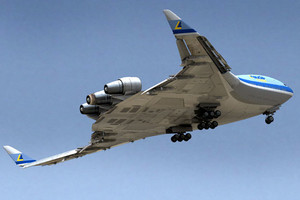

Image: Lockheed Martin
Lockheed Martin’s famed Skunk Works has finally unveiled the long-awaited successor to the SR-71 Blackbird. Aviation Week and Space Technology’s Guy Norris pulled the covers off the project that Lockheed Martin is simply calling the SR-72. The new airplane will be roughly the same size as the record-setting Blackbird, but will be able to fly twice as fast as the jet that still holds the speed records.
The new spy plane will be capable of Mach 6 cruise speeds, making it the first hypersonic aircraft to enter service should it be produced. Only the rocket-powered North American X-15 was able to regularly fly those speeds, and the three examples built were used for research. The SR-71 Blackbird is legendary in aviation circles for its Mach 3 capabilities, and different iterations served as a spy plane for 35 years until its retirement in 1998. It still holds several records, including a flight from Los Angeles to Washington D.C. in 64 minutes, 20 seconds.
The new SR-72 has long been rumored and debated, and is part of the U.S. Air Force’s plan for hypersonic capabilities that will allow fast reaction for gathering intelligence around the world. A Mach 6 airplane fills the gap between current surveillance aircraft that can loiter for long periods of time, but don’t have the ability to transit to a new area quickly. The SR-72 is also expected to have optional strike capabilities, according to Aviation Week.
The key to the new airplane, as it was with the SR-71, will be the engines. Lockheed Martin told Aviation Week the company has been working with Aerojet Rocketdyne to build an air breathing engine that combines both a traditional turbine and a scramjet to deliver the Mach 6 performance.
Normal turbine jet engines have problems operating at speeds beyond Mach 2. The original SR-71 used a complicated system of a movable nose cone on the engine, along with vents that prevented shockwaves from interfering with the flow, and slowed the air down enough so that it could be ingested by the engine. Though “unstarts” were a regular problem for Blackbird pilots, and caused problems throughout the life of the airplane.
The new SR-72 will use a turbine-based combined cycle (TBCC) that will employ the turbine engine at lower speeds, and use a scramjet at higher speeds. A scramjet engine is designed to operate at hypersonic velocities by compressing the air through a carefully designed inlet, but needs to be traveling supersonic before it is practical to begin with. So far research projects from NASA, the Air Force and other Pentagon entities have not been able to solve the problem of transitioning from the subsonic flight regime, through hypersonic flight with a single aircraft.
Lockheed Martin told Aviation Week it has found a way to use existing turbine engines, and by lowering the operating speed of the scramjet, make a transition to hypersonic speeds possible.
The aerospace company says it may have a scaled demonstrator of the SR-72 technology flying by 2023. That airplane would be smaller, about the size of the current F-22 fighter and would be optionally piloted. The SR-72 could enter service by 2030.

